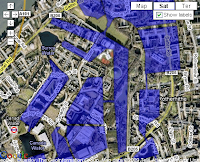
I love days like today when the sky is blue and the sun is shining and it doesn't really matter how cold it is outside because you can dress up warmly and keep moving.
I was out at 1230 after taking rather a long time to assemble the Egyptology News blog, which quite often happens during slow news weeks due to the time it takes to hunt out items of interest. I was wary of departing for the great outdoors due to a bad night's sleep due to tooth ache, which caused me to cancel a trip to northwest London for dinner.
I took the fixed range macro lens because I wanted to capture some of the new buds and shoots that are coming through, but I had the telephoto zoom with me on the offchance that there was any bird life screaming out for a photo opportunity. In fact, there was lots of bird life and the sound of their singing was simply lovely. Close your eyes and open your ears and it sounds more

like Bach orchestration than a random harmony of different species. Robins and tits were the dominant voices, but blackbirds and even a starling added to the music and magpies provided a change the tone. There were dozens of pigeons today, flocking in their usual places.
In some low trees next to the Downtown Pond there were goldfinches, greenfinches and sparrows twittering and calling to each other, bouncing around in the branches. I got one or two abysmal pics of the finches with the macro lens. Unsurprisingly, a macro lens isn't the best of all possible tools for which to take a photograph of a tiny bird on the opposite side of a pond! By the time I had changed lenses they had departed. The one on the right, above, is the best of a very bad bunch.
As was the case yesterday there were very few signs of water fowl around - a couple of mallards, some coots and moorhens.

The vegetation, particularly trees and shrubs, were all showing signs of being about to spring into life, some with buds, others with early bright green leaves, with some of them even in flower.
There was the gorse by the windmill, an unidentified plant with holly-like leaves and yellow sprays of flowers on far edge of the path that winds next to the Russia Dock channel and at the edge of the green. But the absolute highlight of the trip over the road were some early snowdrops, their little white heads bowing and stirring gently in the slight breeze. I'll post more photos of the shrubs and plants over the next couple of days.
There weren't many other people around - a couple of joggers, a few dog walkers and a pair of women with pushchairs. It was very, very quiet.
The Albert Salter bridge, which has been shut off with two ugly metal mesh panels, is still blocked, but there is no indication as to why or, more importantly, when the problem is going to be resolved.




